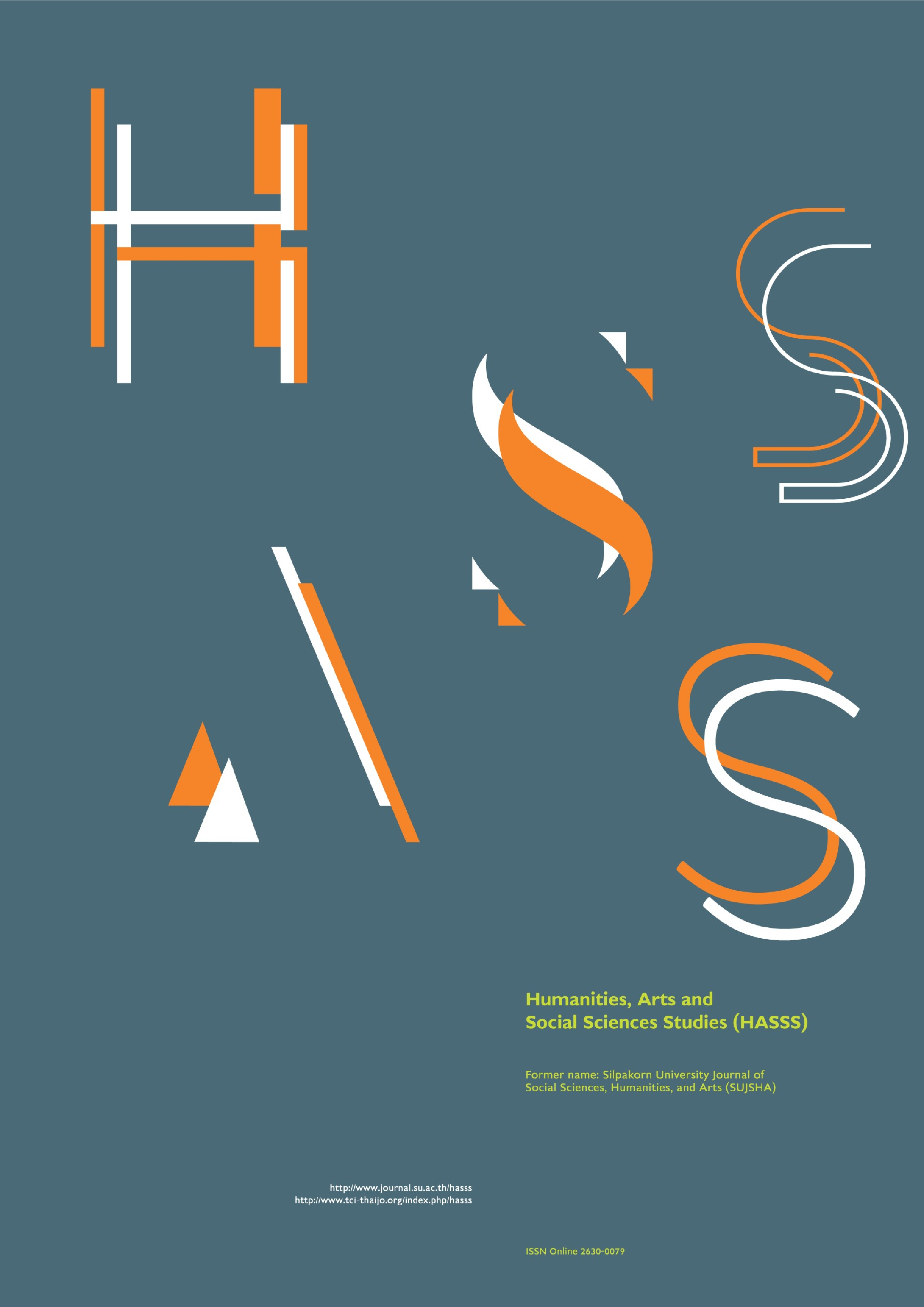Utilization of agricultural waste as a medium for art creation
Main Article Content
Abstract
Rice straw, as an agricultural waste, is usually processed into fodder and openly burnt for faster land preparation for the next growing season. While burning rice straw may be practiced in certain regions to control pests and plant diseases, this perspective disregards the potential drawbacks, such as nutrient loss and CO₂ emissions leading to air pollution. Additionally, the natural decomposition of rice straw emits methane gas, which has an adverse impact on the climate. Eco-friendly rice straw processing is a step to minimize its negative environmental impact. The purpose of this research was to utilize rice straw as a medium in the creation of artworks, which is expected to reduce environmental pollution by maximizing the potential of rice waste (oryza sativa) into the artworks. The research method employed in this study is arts-based research, which draws upon the principles of adapting artistic creativity to social research by utilizing an artistic practice approach, as both domains are considered holistic and dynamic. The artistic practice follows a three-stage experimental sequence: the exploration stage, the design stage, and the embodiment stage. The result of this research indicates that rice straw has a high potential as an alternative to medium variations as well as art creation techniques by processing it into pulp, handmade paper, and clay. While regular paper has coarse light brown fiber and texture, the rice straw clay has a smooth texture. This creative process delivers three elephant-themed relief collages that are environmentally friendly, affordable, and long-lasting.
Downloads
Article Details

This work is licensed under a Creative Commons Attribution-NonCommercial-NoDerivatives 4.0 International License.
All rights reserved. Apart from citations for the purposes of research, private study, or criticism and review,no part of this publication may be reproduced, stored or transmitted in any other form without prior written permission by the publisher.
References
CNN Indonesia. (2020, November 4). Lukisan Timbul dari Abu Jerami [Painting Embossed from Straw Ash] [Video file]. YouTube. https://www.youtube.com/watch?v=KiAs-cG---U [in Indonesian]
Collazo-Bigliardi, S., Ortega-Toro, R., & Boix, A. C. (2018). Isolation and characterisation of microcrystalline cellulose and cellulose nanocrystals from coffee husk and comparative study with rice husk. Carbohydrate Polymers, 191, 205–215. https://doi.org/10.1016/j.carbpol.2018.03.022
Dewi, I. A., Wijana, S., Royyani, D. E., Deoranto, P., Ihwah, A., Romas, M. S., Sunyoto, N. M. S., & Setyawan, H. Y. (2020). Optimisation of bleaching time and H2O2 concentration of handmade paper from Areca catechu L. fibre. IOP Conference Series: Earth and Environmental Science, 475, Article 012090. https://doi.org/10.1088/1755-1315/475/1/012090
DW Indonesia. (2020, August 5). Kemasan Makanan Ramah Lingkungan dari Limbah Jerami Padi [Enviromentally Friendly Food Packaging from Rice Straw Waste] [Video file]. YouTube. https://youtu.be/OFjmETb-Abo [in Indonesian]
Espinosa, E., Tarrés, Q., Delgado-Aguilar, M., González, I., Mutjé, P., & Rodríguez, A. (2016). Suitability of wheat straw semichemical pulp for the fabrication of lignocellulosic nanofibres and their application to papermaking slurries. Cellulose, 23(1), 837–852. https://doi.org/10.1007/s10570-015-0807-8
Gustami, S. P. (2007). Butir-butir mutiara estetika timur: Ide dasar penciptaan seni kriya Indonesia [Eastern aesthetic pearls: The basic idea of creating Indonesian craft]. Prasista. [in Indonesian]
Kaur, D., Bhardwaj, N. K., & Lohchab, R. K. (2017). Prospects of rice straw as a raw material for paper making. Waste Management, 60, 127–139. https://doi.org/10.1016/j.wasman.2016.08.001
Kaur, D., Bhardwaj, N. K., & Lohchab, R. K. (2018). A study on pulping of rice straw and impact of incorporation of chlorine dioxide during bleaching on pulp properties and effluents characteristics. Journal of Cleaner Production, 170, 174–182. https://doi.org/10.1016/j.jclepro.2017.09.111
Leavy, P. (2017). Research design: Quantitative, qualitative, mixed methods, arts-based, and community-based participatory research approaches. The Guilford Press.
Li, H., Sun, H., & He, Z. (2015). Achnatherum inebrians straw as a potential raw material for pulp and paper production. Journal of Cleaner Production, 101, 193–196. https://doi.org/10.1016/j.jclepro.2015.03.061
Perera, B. M. A O. (2009). The human-elephant conflict: A review of current status and mitigation methods. Gajaha, 30, 41–52.
Qomariah, I. N., Rahmi, T., Said, Z., & Wijaya, A. (2019). Conflict between human and wild Sumatran elephant (Elephas maximus sumatranus Temminck, 1847) in Aceh province, Indonesia. Biodiversitas Journal of Biological Diversity, 20(1), 77–84. https://doi.org/10.13057/biodiv/d200110
Sitompul, A. F. (2011). Ecology and conservatison of Sumatran elephants (Elephas maximus sumatranus) in Sumatra, Indonesia [Doctoral dissertation, Universitas Massachusetts Amherst]. ScholarWorks@UMass Amherst. https://doi.org/10.7275/1929690
Su, K., Ren, J., Yang, J., Hou, Y., & Wen, Y. (2020). Human-Elephant conflicts and villagers' attitudes and knowledge in the Xishuangbanna Nature Reserve, China. International Journal of Environmental Research and Public Health, 17(23), Article 8910. https://doi.org/10.3390/ijerph17238910
Tsai, W. T., Chang, C. Y., Wang, S. Y., Chang, C. F., Chien, S. F., & Sun, H. F. (2001). Utilization of agricultural waste corn cob for the preparation of carbon adsorbent. Journal of Environmental Science and Health - Part B Pesticides, Food Contaminants, and Agricultural Wastes, 36(5), 677–686. https://doi.org/10.1081/PFC-100106194
Wang, B., Dong, F., Chen, M., Zhu, J., Tan, J., Fu, X., Wang, Y., & Chen, S. (2016). Advances in recycling and utilization of agricultural wastes in China: Based on environmental risk, crucial pathways, influencing factors, policy mechanism. Procedia Environmental Sciences, 31, 12–17. https://doi.org/10.1016/j.proenv.2016.02.002
Wei, J., Liang, G., Alex, J., Zhang, T., & Ma, C. (2020). Research progress of energy utilization of agricultural waste in China: Bibliometric analysis by Citespace. Sustainability, 12(3), Article 812. https://doi.org/10.3390/su12030812
Widayanto, F. (1993). Ganesha-ganeshi: Seni tembikar karya F. Widayanto [Ganesha-ganeshi: Pottery art by F. Widayanto]. The Jakarta Posts.
Williams, C., Tiwari, S. K., Goswami, V. R., de Silva, S., Kumar, A., Baskaran, N., Yoganand, K., & Menon, V. (2020). Elephas maximus. The IUCN Red List of Threatened Species. e.T7140A45818198. https://dx.doi.org/10.2305/IUCN.UK.2020-3.RLTS.T7140A45818198.en


